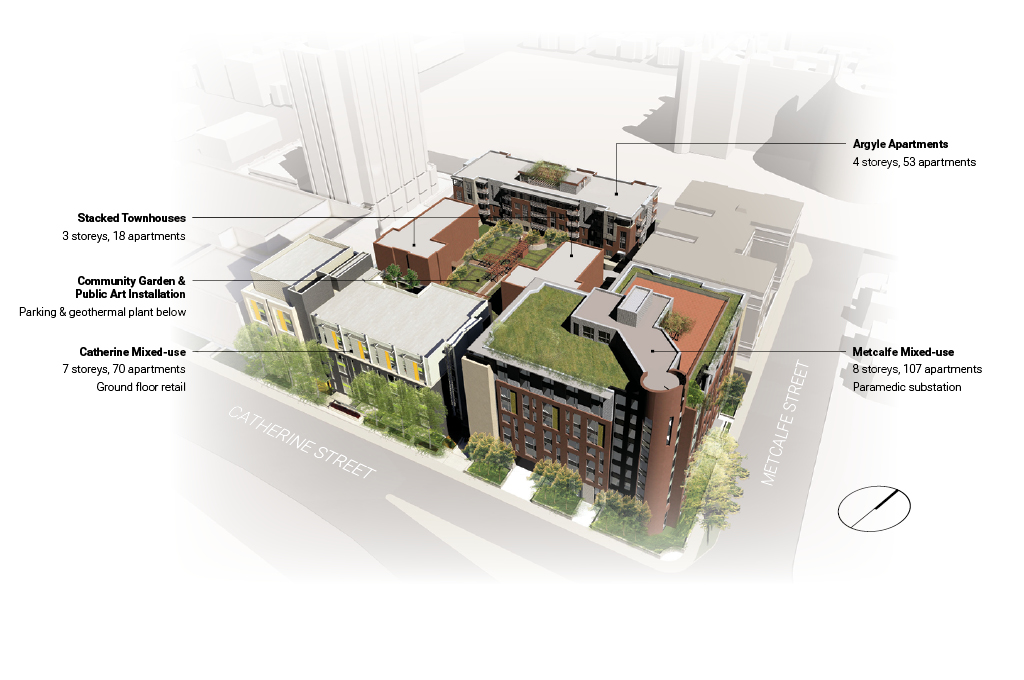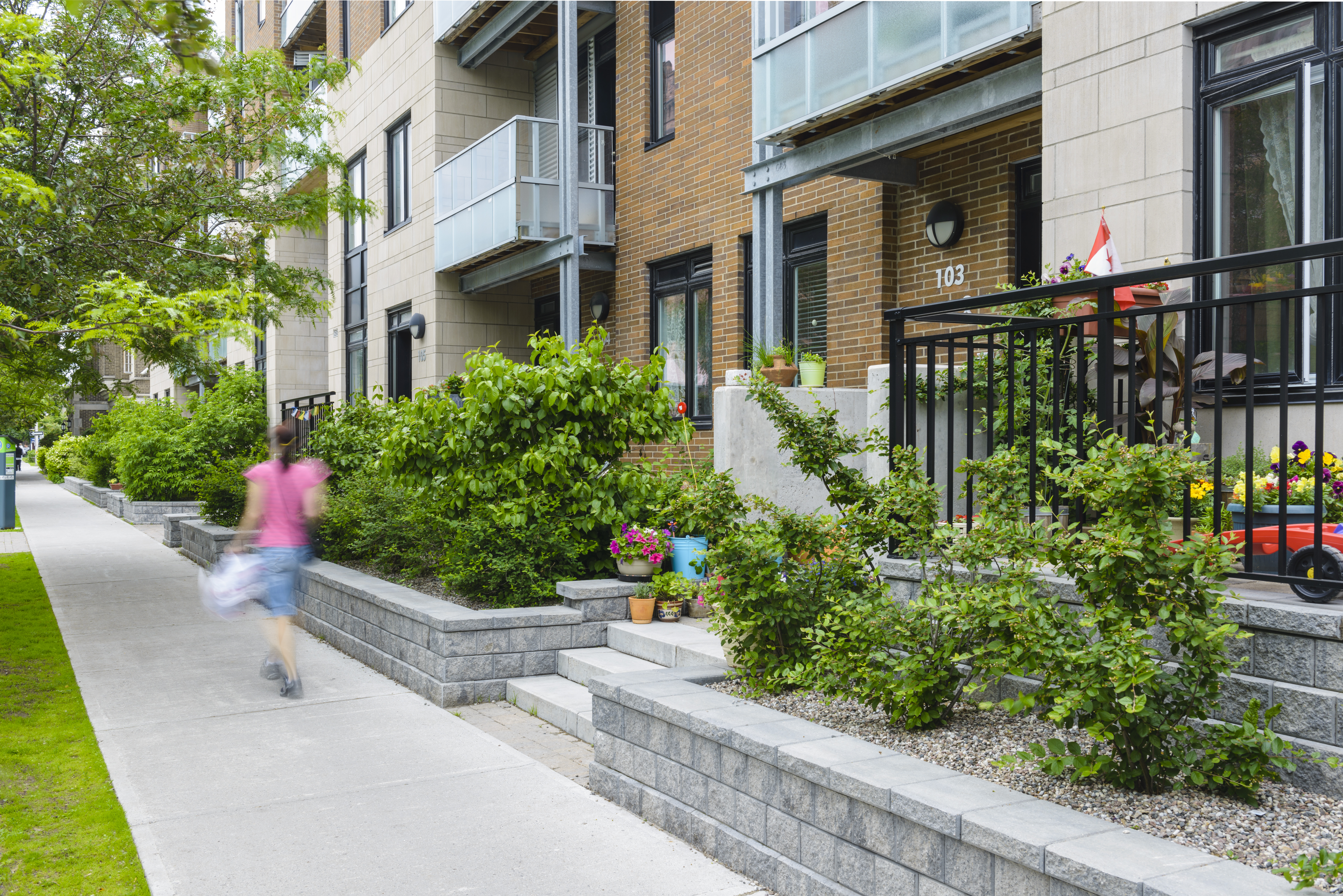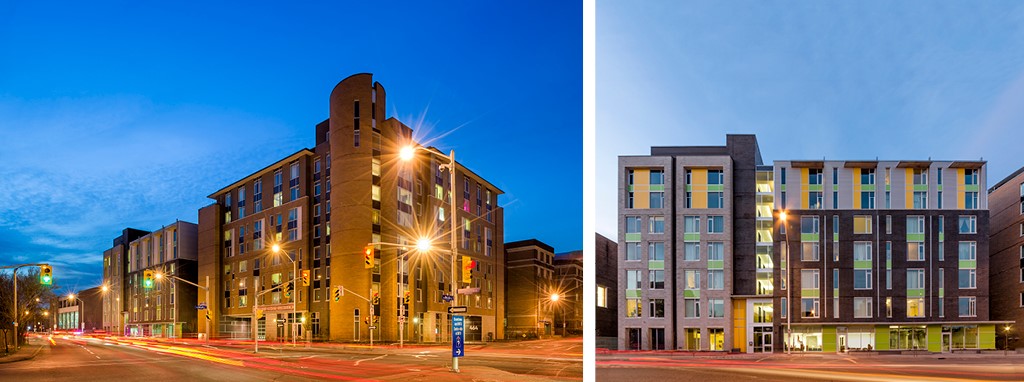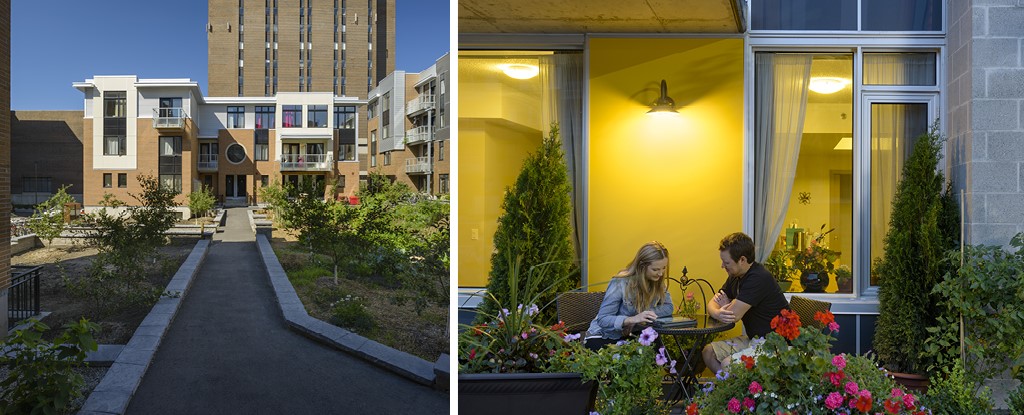Location: Ottawa
Date of Completion: 2010, 2012
Architect: Hobin Architecture Incorporated
Nominated by: Joel Harden, MPP (Ottawa Centre)
“The success of the Beaver Barracks project demonstrates that the affordable housing sector can innovate in energy efficiency."
Ray Sullivan, Executive Director, Centretown Citizens Ottawa Corporation
With 254 dwellings spread across five buildings, Beaver Barracks proves that affordability, inclusivity, and sustainability are not mutually exclusive goals. A former brownfield site, it has been transformed into a landmark mixed-income housing project that has become a case study for responsible and inclusive development.

A 3D rendering of the Beaver Barracks site, laying out the different buildings and amenities in the context of the neighbourhood. Image courtesy of Hobin Architecture
Urban scale
Located in the city’s urban core, steps away from the Canadian Museum of Nature, the Beaver Barracks Redevelopment is a large-scale urban redevelopment that transformed a long-vacant lot into a mixed-income housing community. Occupying half a city block, the project was carefully designed with its context in mind. The development is broken up into five distinct buildings, each with its own architectural character, but all working in unison to support each other and the neighbourhood. Height, mass, and details respond to the specific context of each block while working together to frame an outdoor room for a community garden at the centre. The tallest buildings are adjacent to the highway, creating an acoustic barrier to shelter community spaces within. The low four-storey buildings across from the museum reestablish the historical residential scale and rhythm of this downtown Ottawa street, all while allowing light to penetrate deep into the garden court and views out from the taller buildings beyond.


The different buildings that make up Beaver Barracks purposefully meet the street in various ways, with the various materials, textures and colours playfully adding to the neighbourhood’s character. Photos by Doublespace courtesy of Hobin Architecture
Listening to the community and designing for everyone
Community has always been the key to success for this housing project, with neighbours, residents, and design professionals working collaboratively during the design, construction, and operation of the redevelopment. Before design began, the Centretown Citizens Ottawa Corporation (CCOC)—one of the largest private non-profit housing providers in Ontario and the developer of the project—hosted a two-day design charrette with community organizations, neighbours, designers, engineers, and architects to help establish design priorities for the project. As the project was developed in two phases, feedback from tenants in Phase 1 helped inform decisions in the second phase, particularly regarding finishes and barrier-free design.
A key priority identified during the charrette was fostering community. The design of Beaver Barracks accomplishes this through the inclusion of community spaces, like the central garden and a shared community room. Barrier-free pedestrian paths are subtly integrated throughout the site and buildings to facilitate inclusive interaction of all members of the community. Ten percent of the units are designed for persons with special needs and most units feature barrier-free design features and access paths so that neighbours with disabilities and without can interact with each other.
Careful attention was paid throughout the process to ensure that the residential make-up of the development was reflective of the larger community. Apartments and townhouses are offered at market-value, geared-to-income, and subsidized rents.

The inner courtyard at the centre of the mixed-use development is an important community gathering space, along with providing more private outdoor spaces for residents. Photos by Doublespace courtesy of Hobin Architecture
Sustainability first
Sustainability goals, including energy efficiency and the reduction of greenhouse-gas emissions, were identified early on as a priority for Beaver Barracks which has been designed to LEED Silver level, an internationally recognized green building certification system.
The complex includes a number of sustainable design features including a community garden, thermally broken balcony slabs, high-performance building envelope, and landscaping with native species. Moreover, all 254 units within the development’s five new buildings are served by a central geothermal glycol loop energy recovery system for heating, cooling, and hot water. The system is clean and easy to use, and achieves affordable energy costs for tenants, demonstrating that energy-efficient design need not be considered a luxury.
Looking to encourage further environmental responsibility among residents, CCOC has taken additional actions beyond the building’s design, educating and empowering residents to make more sustainable choices. Prospective tenants receive green property sheets explaining the sustainability features of the complex, how they work, and why they are important. CCOC also organizes workshops and actively communicates sustainable alternatives and practices through signage, providing information on how to conserve water and energy.
Hobin Architecture would like to recognize the work of the following team members on this project: Gord Lorimer (principal in charge), Doug Brooks (Project Director), Jeff Chaput (Technologist), and Steve Clifford (3D Visualization). In addition, Hobin Architecture wishes to acknowledge the work of the sub-consultants for the Beaver Barracks Redevelopment: Paterson Group (Geotechnical), Laroque Levstek Consultants Inc. (Landscape), Novatech Engineering Consultants Inc. (Civil engineers), WSP (Structural Engineers), NORR (M&E), and Morrison Hershfield (Fire and Safety)
The OAA would like to thank Hobin Architecture for their contributions to making this article possible. We would also like to recognize the team behind this project.
This post forms part of our World Architecture Day Queen’s Park Picks 2020 series in which we asked Ontario’s Members of Provincial Parliament to nominate a prominent building, past or present, in their riding for a chance to learn more about it. Check out the rest of the series to learn more about great buildings across the province!